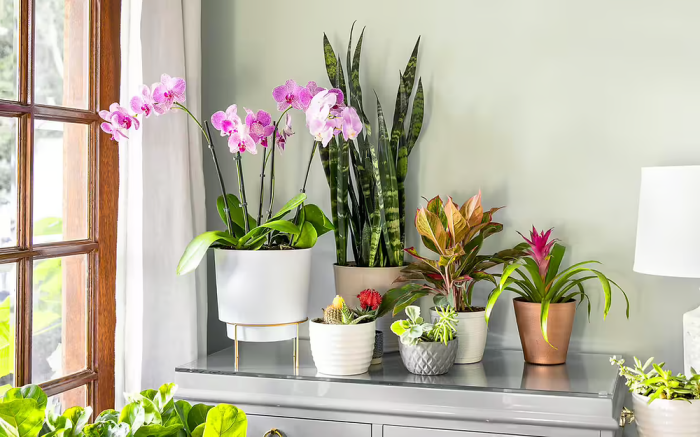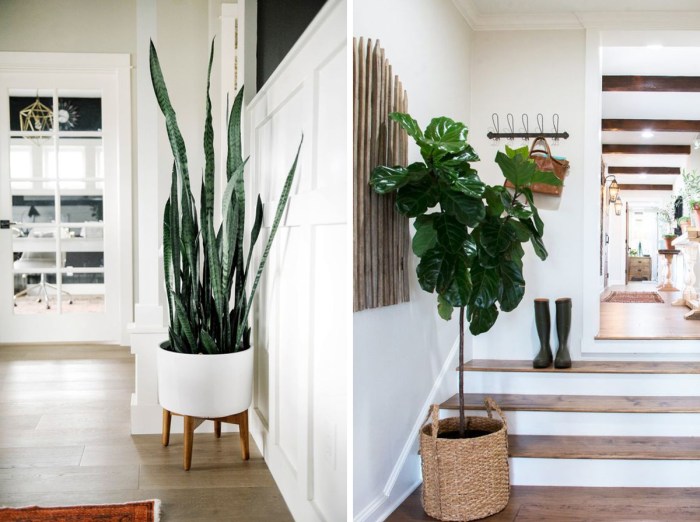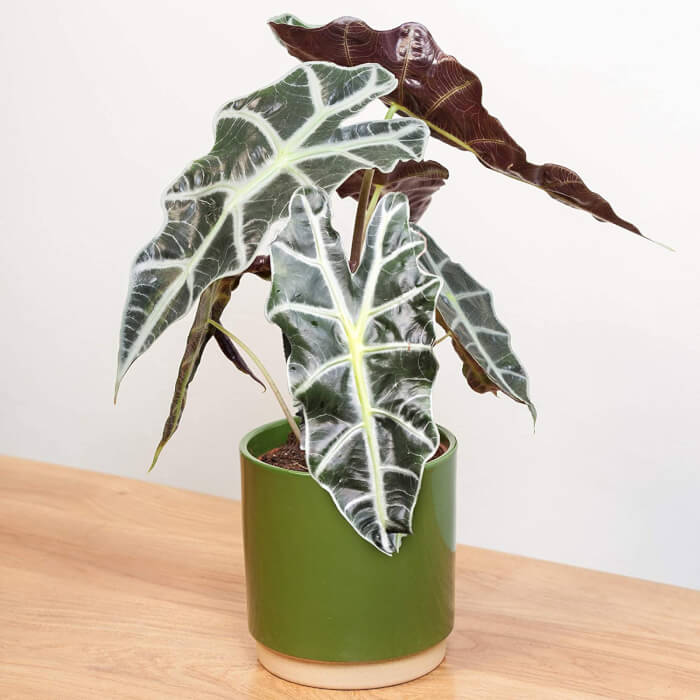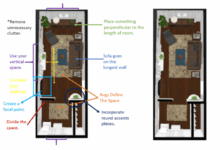Best Indoor Plants For A Fresh Interior Look
Indoor plants are more than just decorative elements; they transform spaces into vibrant oases of life and freshness. With their ability to purify the air and boost our mood, these green companions create a harmonious environment that nurtures both body and spirit. As we delve into the world of indoor gardening, we discover how to choose the right plants, care for them, and showcase their beauty within our homes.
This guide will explore the essential aspects of indoor plants, offering insights into selecting the perfect ones for your living space, enhancing your home’s aesthetic, and maintaining a healthy green environment. From low-maintenance options for beginners to creative decorating ideas, you’ll find everything you need to cultivate a fresh interior look.
Importance of Indoor Plants
Indoor plants are more than just decorative elements; they play a crucial role in transforming our living spaces into refreshing havens. Incorporating greenery into our homes not only enhances aesthetic appeal but also positively impacts our health and well-being. The presence of indoor plants can create a serene atmosphere that encourages relaxation and boosts productivity.Indoor plants are known for their ability to purify the air by absorbing harmful toxins and releasing oxygen.
Studies have shown that plants like the Spider Plant, Peace Lily, and Snake Plant can significantly reduce indoor pollutants such as formaldehyde and benzene. This improved air quality contributes to better respiratory health and can alleviate symptoms associated with allergies and asthma. Furthermore, the act of caring for plants can instill a sense of responsibility and connection to nature, which is vital in our increasingly urbanized lives.
Improvement of Air Quality
The role of indoor plants in enhancing air quality is both impactful and well-documented. The presence of specific plants can lead to a remarkable reduction in indoor air pollutants. Plants naturally filter the air through a process known as phytoremediation, effectively removing toxins from the environment.
- The Spider Plant is particularly adept at removing carbon monoxide and other harmful chemicals from the air. Its ability to thrive in a variety of conditions makes it a popular choice for homes.
- The Peace Lily not only enhances aesthetics but also removes pollutants like ammonia and formaldehyde, contributing to a healthier indoor environment.
- The Snake Plant is known for its resilience and is effective at producing oxygen at night, making it an excellent bedroom companion for improved air quality while you sleep.
Psychological Benefits of Greenery
The presence of greenery in our living spaces has profound psychological effects. Studies indicate that plants can reduce stress levels, enhance mood, and promote a sense of well-being. The simple act of being around plants can elevate our spirits and foster a positive atmosphere.Plants contribute to improved focus and productivity. For instance, incorporating greenery into office spaces has been shown to enhance creativity and increase job satisfaction.
The soothing colors of green and the organic shapes of plants bring about a calming effect that can help mitigate feelings of anxiety and depression.
“Surrounding ourselves with nature, even indoors, can create a profound sense of peace and comfort.”
The connection between nature and mental health is supported by numerous studies. Individuals who work in environments adorned with plants report feeling more relaxed and productive. In educational settings, classrooms decorated with plants have shown to improve students’ concentration and overall learning experience.
Selecting the Right Indoor Plants

Source: wixstatic.com
Choosing the right indoor plants is essential for enhancing the aesthetics of your space while ensuring the health and well-being of the plants. Various factors come into play when selecting plants that will thrive and beautify your interior. Understanding these factors can help you create a harmonious environment that reflects your personal style and living conditions.When deciding on indoor plants, consider the following factors: your space’s light levels, humidity, temperature, and the care requirements of different plants.
Each of these elements can significantly affect the growth and appearance of your plants. Selecting plants that suit your home’s specific conditions is crucial for maintaining their beauty and health.
Low-Maintenance Plants for Beginners
For those just venturing into the world of indoor gardening, choosing plants that require minimal care is advisable. These low-maintenance plants are forgiving and can thrive in various conditions, making them ideal for beginners. Here are some popular options:
- Snake Plant (Sansevieria): Known for its tolerance to low light and infrequent watering, this plant features striking sword-like leaves that can add a bold touch to any room.
- Pothos (Epipremnum aureum): With its vine-like growth and heart-shaped leaves, Pothos is resilient and thrives in low-light spaces, making it perfect for hanging or tabletop displays.
- ZZ Plant (Zamioculcas zamiifolia): This plant is nearly indestructible, requiring little water and tolerating low light, making it an excellent choice for busy individuals.
- Spider Plant (Chlorophytum comosum): Known for its air-purifying qualities and attractive arching leaves, the Spider Plant is easy to care for and produces ‘baby’ plants that can be propagated.
- Peace Lily (Spathiphyllum): With its elegant white blooms and glossy leaves, the Peace Lily thrives in low light and needs only occasional watering.
The above plants not only require minimal effort but also contribute to a refreshing atmosphere in your interior space.
Assessing Light Conditions in Different Rooms
Understanding the light conditions in your home is essential for selecting the right indoor plants. Different rooms may have varying levels of natural light, which can affect plant growth significantly. Here are some key points to consider when assessing these conditions:
Bright Direct Light
Rooms with south or west-facing windows receive abundant sunshine, making them suitable for sun-loving plants like succulents and cacti.
Bright Indirect Light
East-facing windows offer bright, indirect light, ideal for most indoor plants such as Spider Plants and Pothos.
Low Light
Rooms with minimal natural light, such as basements or north-facing windows, can support low-light plants like ZZ Plants and Snake Plants. They can survive with minimal light and still thrive.
Artificial Light
If natural light is scarce, you can use grow lights as an alternative. Many indoor plants can adapt to fluorescent or LED lights, providing a consistent light source for their growth.By taking the time to evaluate the light conditions in your home, you can ensure that your indoor plants will flourish and enhance the beauty of your space.
Popular Indoor Plants for Interiors

Source: co.za
Indoor plants have become a staple in modern interior design, offering not only a refreshing aesthetic but also numerous health benefits. Incorporating greenery into your living space can enhance the atmosphere and improve air quality, making your home feel more inviting. Here, we explore some of the most popular indoor plants that can transform your interiors into a lush oasis.
Trendy Indoor Plants and Their Unique Features
Selecting the right indoor plants can significantly impact the visual appeal of your home. Below are three trendy indoor plants, each with distinct characteristics that make them ideal for various interior styles.
-
Snake Plant (Sansevieria)
The Snake Plant is known for its striking upright leaves that feature sharp edges and a mix of green and yellow hues. This plant is incredibly resilient, thriving in low light and requiring minimal water. Its ability to purify the air by filtering out toxins makes it a favorite among plant enthusiasts.The Snake Plant’s architectural shape adds a modern touch to any room, making it a perfect fit for contemporary or minimalist interiors.
-
Pothos (Epipremnum aureum)
Pothos is admired for its vibrant heart-shaped leaves that can vary in color from deep emerald green to variegated shades of yellow and white. This climbing plant is versatile and can be styled in hanging baskets or allowed to cascade down shelves or furniture.Pothos is also known for its air-purifying qualities, thriving in a range of light conditions while requiring little maintenance. Its lush foliage brings a sense of warmth and liveliness, making it ideal for cozy settings.
-
Spider Plant (Chlorophytum comosum)
The Spider Plant is characterized by its long, arching leaves that form a beautiful rosette. It produces small baby plants, or “pups,” that dangle gracefully from the parent plant, adding an enchanting touch. This plant is highly adaptable and can flourish in various lighting conditions, making it a great choice for beginners.Its ability to filter indoor air pollutants enhances its appeal, while the playful appearance of its pups adds a whimsical element to any decor.
Each of these plants not only brings life to your interior but also contributes to a healthier environment. Whether you prefer the structured elegance of the Snake Plant, the vibrant charm of Pothos, or the playful nature of the Spider Plant, incorporating these greenery options into your home can create a fresh and rejuvenating atmosphere that invites both relaxation and inspiration.
Decorating with Indoor Plants
Indoor plants are not just elements of decor; they are transformative companions that breathe life into our homes. When styled thoughtfully, they can create a serene atmosphere that uplifts our spirits and enhances the overall ambiance of any room. By understanding how to arrange and display these green beauties, one can achieve a fresh and inviting interior look that resonates with nature.To effectively decorate with indoor plants, it’s essential to consider the unique characteristics of each space.
The placement should harmonize with the room’s purpose while reflecting personal style. A variety of factors including lighting, space dimensions, and existing decor can influence how plants are showcased. Here are some ideas to elevate your interior with plants:
Styling Indoor Plants in Various Home Settings
Each room in your home presents an opportunity to express your style through plants. Consider the following approaches for different spaces:
Living Room
Here, larger plants like fiddle-leaf figs or rubber plants can serve as striking focal points. Position them near a window to soak up sunlight, and pair them with smaller plants on side tables for a layered look.
Bedroom
Opt for calming plants such as snake plants or peace lilies. Place them on bedside tables or hang them in macramé holders to create a cozy retreat. Their air-purifying qualities make them a perfect choice for restful environments.
Kitchen
Utilize herbs like basil or rosemary in decorative pots on windowsills. Not only are they functional, but they also add a fresh scent and vibrant color to the kitchen space.
Arranging Plants in Groups for Maximum Impact
Grouping plants can create a stunning visual effect, drawing the eye and enhancing the overall design of a space. Follow these tips for an impactful display:
Vary Heights
Incorporate plants of varying heights to create dimension. Taller plants can be placed at the back of a group, while shorter ones can fill in the front to create a tiered effect.
Mix Textures and Colors
Combine plants with different leaf shapes and colors to add diversity. For example, pairing the broad, glossy leaves of a monstera with the fine, feathery foliage of a fern can create an engaging contrast.
Use a Common Base
Arrange your plants on a tray or in a basket to unify the display. This not only organizes the plants but also adds an additional design element to the arrangement.
Creative Use of Plant Stands and Shelves
Plant stands and shelves provide an excellent way to elevate your plants and showcase them as part of your decor. Here are some creative ideas:
Multi-Level Plant Stands
Utilize tiered plant stands to make the most of vertical space. Placing plants at different heights can create a cascading effect that draws attention to each plant.
Floating Shelves
Install floating shelves to display smaller plants, decorative pots, or trailing plants like pothos. This adds depth to the walls while providing a unique visual interest.
Ladders as Plant Displays
Repurpose old wooden ladders as plant stands. Lean them against a wall and use each rung to hold pots, creating a charming rustic appeal.Incorporating indoor plants into your decor is a rewarding endeavor that can transform your home into a lush sanctuary. By styling, arranging, and showcasing them with care, you not only enhance the visual appeal of your interiors but also enrich your living environment, making it a healthier and more vibrant space.
Plant Care and Maintenance

Source: 1millionideas.com
Indoor plants bring life to our homes, but they also require diligent care to thrive. Establishing a consistent care routine not only keeps your plants healthy but enhances their beauty and longevity. This section delves into the essential aspects of maintaining indoor plants year-round, ensuring they continue to enrich your interior spaces with their vibrant presence.
Care Routine for Indoor Plants
A comprehensive care routine is vital for the well-being of your indoor plants. This routine should encompass watering, feeding, pruning, and monitoring environmental conditions.
- Watering: Assess each plant’s specific water needs, as some thrive on moist soil while others prefer it drier. Generally, indoor plants should be watered when the top inch of soil feels dry. Always ensure proper drainage to prevent root rot.
- Feeding: During the growing season (spring and summer), provide your plants with a balanced liquid fertilizer every month. In fall and winter, reduce feeding, as many plants enter a dormant phase.
- Pruning: Regularly remove dead or yellowing leaves to promote new growth and improve air circulation. Pruning also helps shape the plant and prevent it from becoming leggy.
- Cleaning: Dust can accumulate on leaves, hindering photosynthesis. Wipe leaves with a damp cloth or give plants a gentle shower every few weeks.
- Monitoring: Keep an eye on your plants for signs of pests or disease. Early detection is key to preventing infestations.
Watering Schedules and Humidity Levels
Understanding the needs for water and humidity is crucial for indoor plant health. A consistent watering schedule tailored to your specific plants keeps them hydrated without over-saturating the soil.
Regularly check soil moisture and adjust your watering frequency based on seasonal changes and indoor climate.
Indoor humidity plays a significant role in plant health, especially for tropical species that thrive in higher moisture levels. Here are effective strategies to maintain suitable humidity:
- Grouping Plants: Cluster your plants together; they create a microenvironment that retains humidity.
- Humidity Trays: Place a shallow tray filled with pebbles and water beneath your pots. As the water evaporates, it increases humidity around the plants.
- Misting: Lightly misting plant leaves can provide an immediate boost of humidity. However, this should be done only if the plants are not prone to fungal issues.
- Humidifiers: Using a humidifier in your living space can help maintain a consistent humidity level, especially during dry winter months.
Repotting and Propagating Indoor Plants
Repotting is essential for allowing your plants to grow, as it provides fresh soil and more space for root development. It is typically done every one to two years or when you notice roots growing out of the drainage holes. Choose a pot that is one size larger and provides adequate drainage.
- Repotting Steps:
- Water the plant a day before repotting to reduce stress.
- Gently remove the plant from its pot, loosening the roots if they are tangled.
- Place the plant in the new pot with fresh soil, ensuring it sits at the same depth as before.
- Water thoroughly after repotting to settle the soil around the roots.
- Propagating Popular Indoor Plants: Many indoor plants can be easily propagated, allowing you to expand your collection or share with friends.
- Cuttings: Take a healthy stem cutting with a few leaves, place it in water or soil, and allow roots to develop.
- Offsets: Some plants, like succulents, produce offsets that can be gently removed and potted.
- Leaf Cuttings: Plants such as snake plants can be propagated using a healthy leaf, cut into sections and placed in soil.
Common Indoor Plant Problems
Indoor plants can bring life and vibrancy into your home, but they are not immune to a variety of challenges. Understanding the common problems that may arise can help you maintain a thriving indoor garden. From pests to watering issues, being aware of these factors is the first step in ensuring your plants remain healthy and beautiful.
Common Pests Affecting Indoor Plants
Indoor plants often attract pests that can hinder their growth and overall health. These pests can be detrimental if not managed promptly. Some of the most common pests include:
- Spider Mites: These tiny arachnids suck the sap from leaves, causing discoloration and webbing. Regularly inspecting plants and using insecticidal soap can help control their population.
- Aphids: These small, soft-bodied insects cluster on new growth, leading to distorted leaves. A strong spray of water can dislodge them, and neem oil can be effective against infestations.
- Mealybugs: Recognizable by their cotton-like appearance, mealybugs can be wiped away with a cotton swab dipped in alcohol. Regularly cleaning leaves can prevent these pests.
- Scale Insects: These pests appear as small bumps on stems and leaves, leading to yellowing and leaf drop. Scraping them off with a fingernail or using horticultural oil can help control their spread.
Signs of Overwatering and Underwatering
Watering is critical for indoor plants, but finding the right balance can be tricky. Recognizing the signs of overwatering and underwatering is essential for maintaining plant health.
“Overwatering often manifests as yellowing leaves and root rot, while underwatering typically results in wilting and brown leaf edges.”
Signs of overwatering include:
- Yellowing leaves that feel soft and mushy.
- Leaves dropping unexpectedly.
- Roots that are black and slimy due to rot.
In contrast, signs of underwatering consist of:
- Leaves that are crispy, dry, and brittle.
- Wilting plants that appear lifeless.
- Brown tips on leaves indicating severe stress.
To remedy overwatering, allow the soil to dry out between waterings and ensure the pot has adequate drainage. For underwatering, increase the frequency of watering and ensure that the soil is consistently moist but not soggy.
Preventive Measures for Healthy Indoor Plants
Taking proactive steps can prevent many issues before they occur. Healthy plants are more resilient to pests and environmental stressors.
- Regular Cleaning: Dusting leaves not only helps plants breathe but also deters pests.
- Proper Lighting: Ensure your plants receive the appropriate amount of light, as inadequate light can weaken them.
- Soil Quality: Using high-quality potting mix can provide essential nutrients and proper drainage.
- Humidity Control: Many indoor plants thrive in humid environments; consider using a humidifier or pebble trays for moisture.
- Routine Inspections: Regularly check your plants for any early signs of pest infestations or disease.
Sustainable Practices in Indoor Gardening
Creating a green sanctuary indoors goes beyond choosing the right plants. Integrating sustainable practices in indoor gardening not only promotes a healthier environment but also nurtures a deeper connection to nature. By adopting eco-friendly methods, you contribute to a cycle of growth, care, and responsibility, ensuring that your indoor garden thrives sustainably.Using organic fertilizers is a cornerstone of sustainable indoor gardening.
Organic fertilizers, derived from natural sources, enrich the soil without the harmful effects associated with synthetic chemicals. They improve soil structure, enhance microbial activity, and promote robust plant growth. Unlike their chemical counterparts, organic options release nutrients slowly, providing a steady supply to the plants, and reducing the risk of nutrient runoff, which can pollute local waterways.
Recycling Household Waste as Natural Plant Food
Recycling household waste into natural plant food is an excellent way to nourish your indoor plants while minimizing waste. Many common kitchen scraps can be transformed into nutrient-rich compost or fertilizer.
Vegetable Peelings
Scraps from potatoes, carrots, and other vegetables can add valuable nitrogen and minerals to your compost pile.
Coffee Grounds
Used coffee grounds are rich in nitrogen and can improve soil structure, making them a great addition to your potting mix.
Eggshells
Crushed eggshells provide calcium, which is essential for plant growth and can help prevent blossom end rot in tomatoes.
Fruit Rinds
Citrus peels and other fruit scraps can be composted, providing essential nutrients and attracting beneficial organisms to the soil.By adopting these practices, you not only reduce landfill waste but also enrich your plants’ diet, creating a vibrant indoor ecosystem.
Selecting Environmentally Friendly Plants
Choosing plants that are environmentally friendly can make a significant impact on your indoor gardening experience. Opting for native or drought-resistant species not only conserves water but also supports local biodiversity.
Spider Plant (Chlorophytum comosum)
Known for its air-purifying qualities, this plant is hardy and requires minimal care.
Pothos (Epipremnum aureum)
This resilient vine grows in various conditions and thrives even in low light, making it an excellent choice for beginners.
Peace Lily (Spathiphyllum)
Beyond its beauty, the Peace Lily efficiently filters indoor air pollutants, contributing to a healthier home.
Snake Plant (Sansevieria)
Tolerant of neglect, it produces oxygen at night and is perfect for improving indoor air quality.By selecting these plants, you not only enhance your space aesthetically but also create an eco-conscious environment that benefits both you and the planet.
“Nurturing plants is a way of caring for our planet, one leaf at a time.”
Creative Plant Displays
Creating an inviting interior often hinges on how you display your indoor plants. Innovative plant displays not only elevate the aesthetic of a room but also add a touch of nature that promotes well-being. Experimenting with vertical gardening, unique containers, and hanging plants can transform ordinary spaces into lush retreats filled with life and color.
Vertical Gardening Ideas
Vertical gardening is an ingenious way to utilize wall space, especially in smaller homes where floor area may be limited. By bringing plants up to eye level, you can create a stunning focal point while also maximizing space. Consider the following creative options for vertical gardening:
- Wall-mounted planters: Utilize wooden or metal grids that allow for modular plant placement. This creates an artful arrangement of greenery that can be easily altered.
- Hanging pocket gardens: Fabric pockets attached to a wall can house small plants or herbs, adding a vibrant touch while being functional.
- Trellises with climbing plants: Install trellises and train climbing plants like philodendrons or pothos to grow upwards, providing lush green coverage on your walls.
- Vertical shelves: Use tiered shelves filled with a variety of plants at different heights to create a living sculpture that draws the eye upward.
Unique Containers for Indoor Plants
The containers you choose for your indoor plants can drastically influence the overall decor of your space. Selecting unique pots or planters can enhance the visual appeal and complement the style of your home.Here are some innovative container ideas:
- Reclaimed materials: Old wooden crates, tin cans, and glass jars can be repurposed into charming planters that tell a story.
- Geometric planters: Modern designs featuring angular shapes or asymmetrical styles can add a contemporary twist to your plant displays.
- Macramé hangers: These stylish fabric hangers bring a bohemian flair to your plants and save table space.
- Ceramic art pieces: Choose handcrafted ceramic pots that serve as conversation starters and add character to your interiors.
Hanging Plants for Space Saving and Style
Hanging plants are an effective solution for saving space while introducing vibrant greenery into your home. They draw the eye upward and create a unique layered look in your decor.Consider implementing the following ideas for hanging plants:
- Ceiling hooks and chains: Use sturdy hooks to suspend pots from the ceiling, creating a floating garden effect.
- Window sills: Hang trailing plants like string of hearts or spider plants in front of windows, allowing them to cascade beautifully while maximizing light exposure.
- Plant ladders: A decorative ladder can be leaned against a wall to display hanging pots at different heights, adding an artistic dimension to your space.
- S-hooks on shelves: Utilize existing shelving by hanging smaller plants from the edges with S-hooks, adding an unexpected twist to your arrangement.
Final Summary
Embracing indoor plants not only elevates our home decor but also enriches our lives by improving air quality and promoting well-being. By carefully selecting, styling, and maintaining these plants, we invite a sense of serenity and joy into our spaces. Let the journey of indoor gardening begin, transforming your home into a lush sanctuary with the best indoor plants for a fresh interior look.
FAQ Guide
What are the easiest indoor plants for beginners?
Some of the easiest indoor plants for beginners include Snake Plant, Pothos, and Spider Plant, as they require minimal care and thrive in various conditions.
How often should I water my indoor plants?
Watering frequency depends on the plant type and environment; generally, it’s best to check the soil moisture and water when the top inch feels dry.
Do indoor plants really improve air quality?
Yes, many indoor plants can improve air quality by filtering pollutants and releasing oxygen, contributing to a healthier living space.
How can I determine the right light conditions for my plants?
Observe the natural light in different rooms throughout the day; plants generally need bright, indirect light, but some can thrive in low-light conditions.
What should I do if my indoor plants have pests?
If pests are present, isolate the affected plant and treat it with insecticidal soap or neem oil, and regularly check other plants for any signs of infestation.









